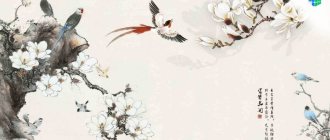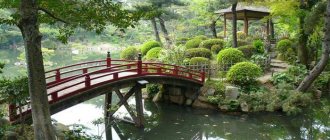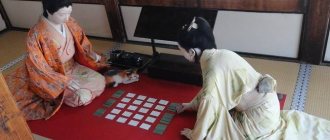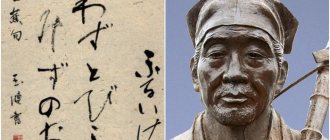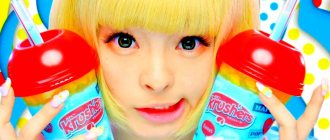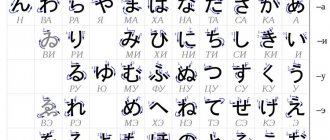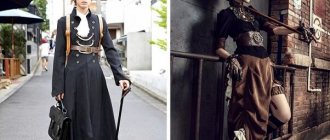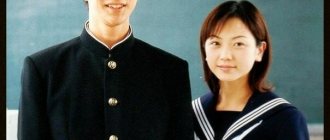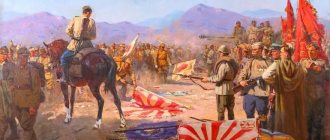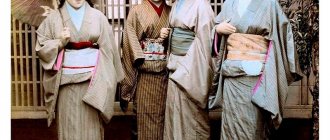About the tank
Tanka , at its core, is a short song, the trendsetter of the Japanese poetic genre. According to tradition, tanka comes from folk ritual and calendar poetry. Thangka shifted long verses called nagauta . The most common theme of medieval Japanese poetry was the seasons. The tanka also reflected all 4 seasons. Often, people’s economic affairs were closely connected with the seasons. Hence another theme - everyday life and the simple life of people. The peculiarity of the tank was the fleeting nature of the mood; they are full of understatements and verbal play. You need to read the tanka with a melody in your voice, slowly and with feeling.
Origin and rise of the genre
Tanka originated in Japanese poetry of the early Middle Ages (8th century) and reached its peak in the 9th–10th centuries, becoming a traditional poetic form of aristocratic literature in Japan along with nagauta and sadoka. Classic examples of the genre are presented in medieval anthologies of Japanese lyric poetry, which were published by order of the emperors. The work of the “six immortal” poets of Japan (9th century) is rich in tanka poems: Ariwara no Narihira, Ono no Komachi, Henjo, Funya no Yasuhide, Kisen-hoshi, Otomo Kuronushi.
Anthology "Man'yoshu"
"Man'yoshu", manuscript from the collection of Waseda University.
The first and most recognized anthology of Japanese poetry is Manyoshu (Collection of Myriad Leaves), dating back to approximately 759. Of the 4,516 works in the poetry collection, 4,207 are short tanka songs, among the authors of which were Yamabe no Akahito and Kakinomoto no Hitomaro , Otomo no Tabito, Yamanoue no Okura, Takahashi Mushimaro, Otomo no Yakamochi.
About haiku
Haiku , or haiku, is probably the most popular genre of Japanese poetry throughout the world. This genre originated in the 14th century. But haiku became an independent genre only in the 16th century. In general, haiku originally meant the first stanza of renga, or the first stanza of tanka. The term haiku is an author's one; it was proposed by the Japanese master, poet and critic Masaoka Shiki only in the 19th century. The role of haiku is difficult to overestimate, because haiku was aimed at democratizing Japanese poetry. Haiku at that time was a new trend in poetry, but even then it freed everything from canons and rules. It was a real revolution in the field of posing. The haiku school attracted educated people from among the intelligentsia into its ranks, and there was a kind of “descent” of poetry to the masses.
By the way
Haiku grew from simple peasant entertainment into court poetry. At the court of every Chinese and Japanese emperor there was a poet who composed haiku. Often such poets came from simple families, but their skill in writing haiku was excellent and the emperor bestowed upon them wealth and titles.
The main themes of haiku were court intrigue, nature, love and passion.
Tank history and examples
The origins of tanka are in folk legends and oral poetry of the era of the tribal system. Currently, tanka is cultivated as the main form of Japanese national poetry. In the 13th-14th centuries. There was a satirical genre - rakushu, and in later times - humorous poetry kyoka (literally "mad poems"), which also use the tanka stanza, that is, 5-7-5-7-7.
The poet Tsurayuki (9th - early 10th centuries) defines tanka as poetry “whose roots are in the human heart”
.
A poem composed according to this form can contain up to 50 or 100 lines, in which case it is called chōka (長歌chōka
, “long song”), or nagauta (Japanese 長歌
nagauta
), however, most Japanese tanka consists of five lines according to the pattern - 5-7-5-7-7, for a total of 31 syllables.
The Japanese three-line haiku (or haiku) and tanka five-line lines are widely known throughout the world. The epitaph of the greatest Japanese poet of our century, Ishikawa Takuboku, became his most famous tanka:
Piercing bitter lines; the unobtrusive but obvious antithesis of the eternal life of nature and the brevity of human existence is contained in these few meager lines.
At the turn of the century, several poetic cycles appeared in the genres of Japanese lyricism. This is "Imitation Japanese"
Vyacheslav Ivanov,
“Japanese Tanks and High-Kai”
by Valery Bryusov,
“Five Tanks”
by Andrei Bely.
This is what V. Bryusov’s Japanese tank looks like:
In the blue of the pond
the White Stork is reflected; A moment - no trace. Your image is locked in a poor heart forever.
Haiku structure
If we compare haiku with tanka, then tanka reveals more of the essence, but in haiku there is more emotionality: all the shades and colors of feelings, emotions, thoughts and experiences. Haiku grew out of a tank. Haiku is a lyric poem. The main themes of haiku, like tanka, are the themes of nature, the harmony of man with nature, and the depiction of human life against the backdrop of the cycle of the seasons.
Haiku has a stable meter and a peculiar lyricism. The poet's skill is expressed in the ability to say a lot in three lines.
Haiku consists of 17 syllables arranged in a specific order. Regular pattern: 5-7-5. Haiku is a tercet, so it is written, according to the rules, in three lines. These limitations make writing haiku difficult.
The task of every haiku master is to infect the reader with the same mood, reflection or feelings from the experience. If he succeeds, then this is the highest reward for a poet.
In order to convey an accurate picture, it is not necessary to paint it on several pages; just a few words, or rather 17 syllables, are enough. In haiku, as in tanka, every word is very significant; you need to be careful about the choice of words, even prepositions and conjunctions. Tradition and respect for the past have made haiku a true work of art in Japan, as, for example, the art of calligraphy.
Tanka
Tanka is an ancient genre that has long delighted fans of Japanese poetry.
To be as precise as possible, this is a song. There are first mentions of Tanka back in the eighth century. These are pentaverses, which usually consist of 31 syllables. Tanka is distinguished by some kind of understatement, subtle and fleeting mood of the author, poetically elegant, and evokes a storm of emotions. Tanka is a five-line poem, which, with the passage of time, began to be divided into three lines and an additional two lines. It happened that one poet composed the first 3 lines, and the other, the rest of the work. But four centuries later, a new direction of poetry appeared, which took the name “Renga”. It arose from the tank, only in it, the stanzas continue to repeat. Renga does not have a unified theme, but most often it talks about nature, indicating the seasons.
Japanese poet Matsuo Basho
Matsuo Basho is not just a poet and master of haiku, but also a man who created an entire aesthetic school of Japanese poetics of that time.
Matsuo Munefusa is the real name of the author, who was born in a beautiful and sonorous place called Ueno. It is a castle town in the small province of Iga. His father was a poor samurai. But the author’s relatives were educated people, which made it possible to recognize classical Chinese writers. His older brother and father gave him calligraphy lessons. Well, the author himself was friends with the prince’s son, who could not imagine life without poetry. This served as the initial stage of his creativity. Very soon Basho decided to try himself in this genre. After his comrade died, he left and took monastic vows, thereby freeing himself from service to the feudal lord. But he never became a monk. He studied with the best masters of that time. Later, when fame came to him, he himself became a teacher for many aspiring poets.
Haiku (haiku) and tanka
Japanese poetry
based on the alternation of a certain number of syllables. There is no rhyme, but much attention is paid to the sound and rhythmic organization of the poem.
Haiku, or haiku (initial verses), is a genre of Japanese poetry: an unrhymed tercet of 17 syllables (5+7+5). The art of writing haiku is, first of all, the ability to say a lot in a few words. Genetically, this genre is related to tanka.
Tanka (short song) is the oldest genre of Japanese poetry (first recorded in the 8th century). Unrhymed five-line verses of 31 syllables (5+7+5+7+7). Expresses a fleeting mood, full of understatement, distinguished by poetic grace, often complex associativity, and verbal play.
Over time, the tanka (five-line) began to be clearly divided into two stanzas: a tercet and a couplet. It happened that one poet composed the first stanza, the second - the subsequent one. In the twelfth century, chain verses appeared, consisting of alternating tercets and couplets. This form was called "renga" ("strung stanzas"); The first tercet was called the "initial stanza", or haiku in Japanese. The renga poem did not have a thematic unity, but its motifs and images were most often associated with a description of nature, with an obligatory indication of the season. The opening stanza (haiku) was often the best stanza in the rengi. This is how separate collections of exemplary haiku began to appear. The tercet became firmly established in Japanese poetry in the second half of the seventeenth century.
Haiku has a stable meter. This does not exclude poetic license, for example, in Matsuo Basho (1644-1694). He sometimes did not take into account the meter, striving to achieve the greatest poetic expressiveness.
Matsuo Basho is the creator not only of haiku poetry, but also of an entire aesthetic school of Japanese poetics. His real name is Matsuo Munefusa. Born in the castle town of Ueno, Iga Province (in the center of the island of Honshu), in the family of a poor samurai, Matsuo Yozaemon. Basho's relatives were educated people, which primarily presupposed knowledge of the Chinese classics. Basho's father and older brother taught calligraphy. Since childhood, Basho himself was a friend of the prince's son, a great lover of poetry; Soon Basho himself began to write poetry. After the early death of his young master, Basho went to the city and took monastic vows, thereby freeing himself from serving his feudal lord, but did not become a real monk. He studied with the then famous haiku poetry masters Katamura Kigin and Nishiyama Soin. In 1680 he published the first anthology of his own poems and those of his students. Then he settled in a hut on the outskirts of Edo (Tokyo). In 1684 he began to travel like his favorite poet Saigyo. As Basho's fame grew, students of all ranks began to flock to him. By the end of his life, he had many students all over Japan, but Basho’s school was not the usual school of a master and students listening to him at that time: Basho encouraged those who came to him to find their own path, each had their own handwriting, sometimes very different from the handwriting of the teacher. Basho's students were Korai, Ransetsu, Issho, Kikaku; Chiyo belongs to the Basho school, a talented poetess who, having become a widow at an early age and having lost a child, became a nun and devoted herself to poetry...
Basho (1644-1694)
Silence all around. Voices of cicadas penetrate into the heart of the rocks.
Old pond. A frog jumped into the water. A splash in silence.
The water is so cold! The seagull cannot sleep, rocking on the wave.
This wild ivy has wrapped its life around the hanging bridge.
Oh, how many of them there are in the fields! But each blooms in its own way - This is the highest feat of a flower.
Issho (1653-1688)
My eyes saw everything in the world - and returned to you, white chrysanthemums.
Ransetsu (1654-1707)
The autumn moon draws a pine tree with ink in the blue skies.
Chiyo (1703-1775)
To the death of a little son
O my dragonfly catcher! Where into the unknown distance have you run today?
Dew on saffron flowers! It will spill onto the ground and become simple water...
Spring plums give their aroma to a person... To the one who broke the branch.
I forgot that my lips were painted... Pure source!
Buson (1716-1783)
Heavy bell. And at its very edge a butterfly is dozing.
I climbed the hill, Full of sadness, and what: There are wild roses in bloom!
The dew has fallen, and droplets hang on all the thorns.
The cold penetrated to my heart: I stepped on the crest of my deceased wife in the bedroom.
Issa (1768-1827)
The pheasant screams like that, as if he had discovered the first star.
There are no strangers between us! We are all brothers to each other Under the cherry blossoms.
The tree is ready to be cut... And the birds carefreely build a nest there!
Oh, with what longing the bird from the cage looks at the flight of the moth!
In the thickets of weeds, Look what beautiful Butterflies were born!
Sad world! Even when the cherry blossoms... Even then...
On the death of a young son:
Our life is a dewdrop. Even if only a drop of dew is Our life - and yet...
From the book: Butterflies in flight. Japanese tercets / Trans. from Japanese V.N. Markova. - M., 2000.
